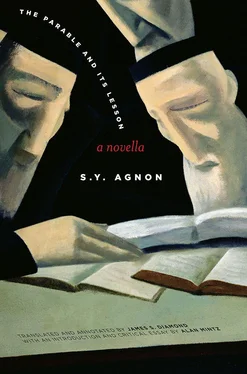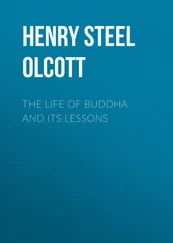18 tashlikh ritual The water used for making Passover matzah must be “water that has stood overnight,” such that the dough will be sufficiently cool so as not to make it ferment quickly. The water must be drawn by a Jew from a river or well, placed in a clean vessel, and allowed to stand overnight or at least for twelve hours. Tashlikh (casting away) is the ritual performed on Rosh Hashanah afternoon or in the days following, in which one’s sins are symbolically cast away into a naturally flowing body of water.
19 My beloved knocks Song of Songs 5:2.
19 for Thou art with me Psalm 23:4.
20 from the hollow of the sling The reference here is to the Babylonian Talmud, tractate Shabbat 152b, where the two parts of a biblical verse (1 Samuel 25:29) are cited and interpreted: “R. Eliezer said, ‘The souls of the righteous are ensconced beneath the heavenly throne, as it is written, May the soul of my lord be bound up in the bundle of life in the care of the Lord . But the souls of the wicked are perpetually confined [to the hollow of a sling] and an angel stands at one end of the universe and another angel stands at the other end of the universe and they sling the souls [of the wicked back and forth] to one another, as it is written, But He will fling the souls of your enemies as from the hollow of a sling’ .”
21 Ari Acronymic name of Rabbi Isaac Luria (1534–1572), Jewish mystic and a major theorist of Kabbalah.
21 raising up the souls The four letters of the Hebrew word mishnah can be transposed to the word neshamah (soul).
23 the Kanah and the Peli’ah Sefer ha-peli’ah and Sefer hakanah are works of cosmogonic and theosophic speculation. Their authorship is uncertain, as are their date and country of origin. Some scholars place them in Spain of the late fourteenth century. Both works are marked by a strong antinomian strain.
23 will find the door open to him Babylonian Talmud tractate Menaḥot 29b and in other places with variants.
23 what will be in the end The allusion is to Mishnah Ḥagigah 2:1: “Whoever gives his mind to four things, it were better for him had he not come into this world: what is above, what is beneath, what was beforetime, and what will be in the hereafter.”
24 the superhuman sons of God See Genesis 6:1–4.
24 over the surface of the deep Genesis 1:2.
24 the domain of the qelipot Elhanan Shilo, in a private correspondence, notes that Agnon’s language here is citing Naftali Bacharach in his book expositing Lurianic Kabbakah, Emek hamelekh , 16:11.
24 induced its curse within him See Numbers 5:11–31, where the procedure prescribed for a woman suspected of adultery is detailed.
24 and an inner one Otzar hamidrashim, ‘olam katan , no. 4.
25 to sleep in one’s house all alone Babylonian Talmud tractate Shabbat 151b.
26 from transgression, says the Lord Isaiah 59:20.
27 his share in the world to come Babylonian Talmud tractates Bava Metziah 59a and Sanhedrin 107a.
28 than the flights of desire Ecclesiastes 6:9.
28 a compartment they call Tsalmavet The idea that Gehinnom is composed of different compartments is found in the Babylonian Talmud tractates Sotah 10b and ‘Eruvin 19a.
28 larger than Earth Job 11:9.
29 wrapped in silver-crowned talitot Exodus 12:37 and Numbers 11:21 report that 600,000 adult males went forth from Egypt. This number is made more precise in the censuses noted in Exodus 38:26 and Numbers 1:46, where the figure given is 603,550 adult males. Accordingly, when women and children are added, the total of those who left Egypt would be over two million. Thus the number of people implied here is astronomical.
29 chief rabbis and heads of yeshivot Chief rabbis or Landesrabbiner were regional head rabbis of districts and provinces in the countries of Central Europe. A Rosh Yeshivah is the head rabbi of a talmudical academy (Yeshivah).
29 Sabbath boundary The Sabbath boundary ( teḥum shabbat ) is the distance beyond the defined city limits that one is permitted to walk on the Sabbath, stipulated in rabbinic sources as two thousand cubits or about three-quarters of a mile.
31 has given to mankind Psalm 115:16.
31 Otem This name comes from the Hebrew root ‘atom , to stop up, as in Proverbs 21:13 Who stops his ears at the cry of the wretched .
31 what the living say Based on Babylonian Talmud tractate Berakhot 27b.
33 their own compartment of Gehinnom See Midrash Ecclesiastes Rabbah 3:9 for the idea that individuals of like profession or vocation are assigned to their own particular compartment of Gehinnom.
33 a candle of the Lord Proverbs 20:27.
34 whose transgression is forgiven Psalm 32:2.
34 forgives iniquity Exodus 34:6–7.
35 cross through your land Leviticus 26:6.
35 in accordance with Your word Psalm 119:28.
35 in rumbling hordes After the Khmelnitski massacres of 1648, there were serious invasions of Galicia by Tatars and Turks in the 1670s.
36 to get the atonement chickens The reference is to the kaparot (lit. expiations) ceremony performed by observant Jews on the morning of the day before Yom Kippur, in which the sins of an individual are symbolically transferred to a live fowl. The fowl — a rooster for a man, a hen for a woman — is swung around the head three times as biblical verses and a formula of vicarious atonement is recited. Money in the amount of the fowl’s value is often substituted for the fowl.
36 Book of the Angel Razi’el Sefer Razi’el hamalakh , an early medieval book of instruction in magical lore and practices written in Hebrew and derived from the Jewish mystical tradition (Kabbalah). Its precise date and authorship are uncertain.
36 never asked anyone to get his staff for him Babylonian Talmud tractate Sotah 10a. The implication is that Samson not only did not take bribes which blind the eyes of the wise (Deuteronomy 16:19) but sought no favors of any kind from anyone.
36 recited the Torah blessings In the morning regimen, after the hands are washed and before the service proper, three short blessings concerning the giving and the study of Torah are recited, followed by readings from the Written Law (the Priestly blessing, Numbers 6:24–26) and the Oral Law (Mishnah Pe’ah 1:1) and the preliminary morning blessings.
37 who crowns Israel in glory One of the blessings preliminary to the morning service. The letters on the parchments inside the tefillin are, like those on the Torah scroll, typically embellished by the scribe with tiny filigreed crowns over them.
37 talmudic tractate Yevamot A key source for many of the laws pertaining to an agunah.
37 lasts for twelve months As stated by Rabbi Akiva in Mishnah ‘Eduyot 2:10.
37 worse than the heat of the sun These details of Gehinnom are drawn from various midrashic sources.
39 young men and women Psalm 148:12.
40 area forbidden to kohanim A kohen is required by Jewish law to remain in a state of ritual purity. Physical presence near a corpse or in a cemetery defiles him.
40 implored the Lord Exodus 32:11. On public fast days at the afternoon service, the prescribed reading from the Torah is Exodus 32:11–14 and 34:1–10. The haftarah (reading from the prophetic books of the Bible) is Isaiah 55:6–56:8.
40 to those already gathered Isaiah 56:8.
Читать дальше












![Edward Ellis - Adrift on the Pacific - A Boys [sic] Story of the Sea and its Perils](/books/753342/edward-ellis-adrift-on-the-pacific-a-boys-sic-s-thumb.webp)